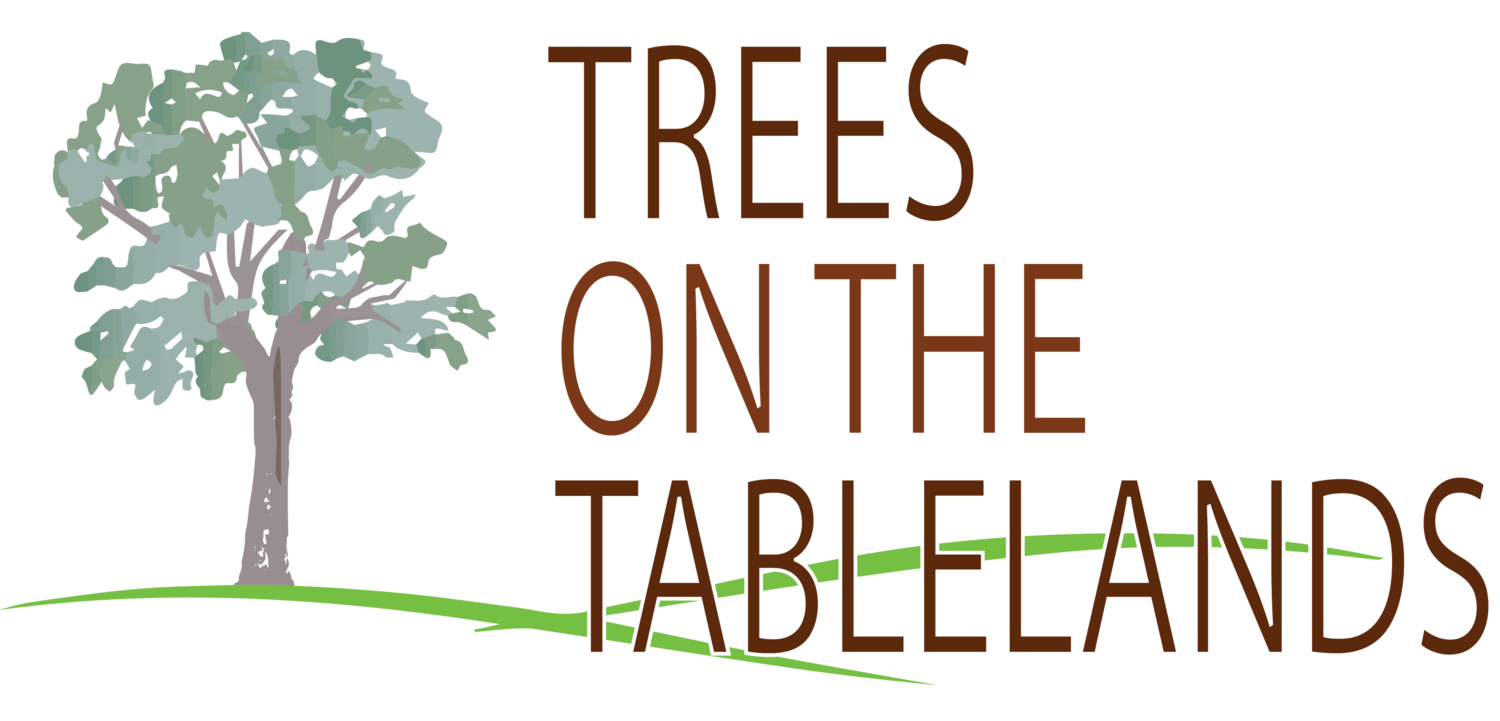Ribbon Gum
(Eucalyptus viminalis)
A prominent member of the endangered Ribbon gum – Mountain-gum – Snow-gum grassy forest/woodland community is Eucalyptus viminalis, commonly referred to as ‘Ribbon-gum’ or ‘Manna-gum’. Eucalyptus viminalis trees are often found growing as a co-dominant species with Mountain gum (E. dalrympleana) and Snow gum (E. pauciflora) or alongside Yellow-box (E. melliodora) and Red-gum (E. blakelyi), however, can occur in mono-dominant stands throughout the Northern Tablelands bioregion (Figure 1). Capable of growing to an impressive height of 30 to 40 m where the soil is deep and sub-surface water ample, E. viminalis is often found in mid to upper-slope landscape positions, however, can occur on lower slopes in the ecotone to New-England Peppermint (E. nova-anglica) woodland. Stands of E. viminalis are most common on substrates derived from basalt parent material, but also occur on sediments and meta-sediments. A shrub layer often occupies the structural mid-story within stands of E. viminalis and can include species such as Acacia sp., Pultenaea sp., and Bursaria spinosa. Mid-story shrubs provide vital habitat for small birds and insect communities in both food resources and nesting spaces. As older Ribbon gums readily form nesting hollows, mature woodlands can host a diverse assemblage of small mammals such as the yellow-bellied glider and possum. Throughout the winter period, these woodlands become a valuable food source, producing an abundance of nectar-rich flowers for birds and insects along with an important food source for koalas. Many species also seek out the sugary white ‘manna’ exuded from young foliage and trunks of mature trees.
Figure 1: Dominant Ribbon-gum (Eucalyptus viminalis) woodland on the Northern Tablelands near Uralla. Photo Ben Vincent
The immediate identifying characteristics of Eucalyptus viminalis is its shedding bark that hangs in long strips from the canopy, branches, and trunk (Figure 2). The annual shedding of bark in long ribbons exposes the smooth white bark underneath which can vary in colour during the season to yellow or pink. Other prominent adult characteristics include leaves that are disjunct, lanceolate, glossy green, and concolourous (Plantnet, 2022). As E. viminalis can vary in bark and leaf morphology, identification by juvenile leaves may be necessary. Juvenile leaves are commonly present on young saplings but also as epicormic growth along the trunk and branches of adult trees following disturbance. Juvenile leaves are identifiable as opposite, sessile, and lanceolate to broad-lanceolate in shape (Figure 2).
Flowering generally occurs between March and April but can continue throughout winter. Buds are often arranged in groups of three but can be found in groupings of up to seven. Creamy-white flowers produce an abundance of nectar and pollen, with trees often attracting bird species to the tablelands bioregion. Hemispherical fruits with exerted valves develop throughout the winter period, with fruit being held in the canopy for roughly 12 to 15 months. As fruits mature the following summer they begin to brown off in warmer weather, with seed fall occurring sporadically over 6 to 12 months or more.
Figure 2: Identifying characteristics of Ribbon-gum – Eucalyptus viminalis. Top left: Juvenille leaves from young seedling. Bottom left: Mature adult leaves. Top right: Buds. Bottom right: Mature fruit. Center: Bark. Photos Ben Vincent.
Threats
As a member of the endangered Ribbon-gum – Mountain-gum – Snow-gum ecological community, E. viminalis has in turn been subjected to extensive clearing and fragmentation since agricultural settlement 130 years ago. As such, E. viminalis plays an important role in rehabilitating these fragmented ecological communities throughout the Northern Tablelands. Ribbon gums are easily cultivated, fast-growing, and can tolerate harsh climatic conditions including severe frosts and drought. These trees are utilised in agricultural production systems as paddock or windbreak shelter trees for grazing livestock. Furthermore, Ribbon-gums are a suitable species to combat gully erosion due to their ability to grow rapidly in wet cold conditions. Due to the vast majority of remaining populations of E. viminalis occupying private lands, local landholders have a unique opportunity to play a pivotal role in conserving and expanding this unique woodland community. To learn more about how you can contribute, see our techniques and resources sections.
Key features
Ribbon gum often grows as co-dominant to Mountain gum (E. dalrympleana) and Snow gum (E. pauciflora)
Communities are often located in fertile, deep soil substrates across the mid to upper slope landscape positions
Flowering is March to April, with fruit held in the canopy for 12 to 15 months
Ribbon gum is an important food source and habitat for many animals and insects including koalas
Can make a great species for planting in windbreaks and shelterbelts
References
PlantNET - The NSW Plant Information Network System (2022). Royal Botanic Gardens and Domain Trust, Sydney. https://plantnet.rbgsyd.nsw.gov.au/cgi-bin/NSWfl.pl?page=nswfl&lvl=sp&name=Eucalyptus~viminalis#:~:text=PlantNET%20%2D%20FloraOnline&text=Eucalyptus%20viminalis%20Labill.&text=Description%3A%20Tree%20to%2030%20m,opposite%2C%20lanceolate%2C%20dull%20green accessed on 27/06/2022
Ribbon Gum (Eucalyptus viminalis) seedling
Ribbon Gum (Eucalyptus viminalis) adult tree
Ribbon Gum (Eucalyptus viminalis) woodland
Ribbon Gum (Eucalyptus viminalis) large hollow and nesting wood ducks




